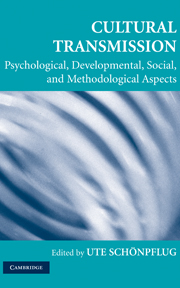Book contents
- Frontmatter
- Contents
- Foreword
- Contributors
- 1 Introduction to Cultural Transmission: Psychological, Developmental, Social, and Methodological Aspects
- 2 Theory and Research in Cultural Transmission: A Short History
- PART ONE EVOLUTIONARY PERSPECTIVE
- PART TWO CROSS-CULTURAL PERSPECTIVE
- PART THREE INTRACULTURAL VARIATIONS
- Index
- References
2 - Theory and Research in Cultural Transmission: A Short History
Published online by Cambridge University Press: 05 June 2012
- Frontmatter
- Contents
- Foreword
- Contributors
- 1 Introduction to Cultural Transmission: Psychological, Developmental, Social, and Methodological Aspects
- 2 Theory and Research in Cultural Transmission: A Short History
- PART ONE EVOLUTIONARY PERSPECTIVE
- PART TWO CROSS-CULTURAL PERSPECTIVE
- PART THREE INTRACULTURAL VARIATIONS
- Index
- References
Summary
INTRODUCTION
Transmission may be understood as the deliberate or unintended transfer of information from a transmitter to a transmittee. The concept of cultural transmission, however, indicates the transmission of culture or cultural elements that are widely distributed: social orientations (e.g., values), skills (e.g., reading and writing), knowledge (e.g., the healing power of certain herbs), and behaviors (e.g., the exchange of rings in a wedding ceremony). The scope of this distribution defines the boundaries of the respective culture. The research traditions presented herein reveal that theorists have generally thought of cultural transmission as a process of replication of whatever is transmitted in another individual or in other groups. However, as pointed out by Reynolds (1981) (see also Henrich & Boyd, 2002), the replication has its limits. This debate is elaborated on throughout this chapter.
The transmission of culture is a necessary process to maintain culture; thus, it has always taken place, from ancient to newly developed cultures. In traditional, slowly changing societies, the transmission of culture is a common undertaking of the older generation applied to the younger generation. The mechanisms involved in the cultural transmission of either slowly or rapidly changing societies form the basis of various theories that have been developed in the history of transmission research.
The history of cultural transmission theories and research is characterized by interdisciplinary contributions. This chapter traces the origins and ramifications of theoretical approaches and looks at empirical evidence and counter-evidence.
- Type
- Chapter
- Information
- Cultural TransmissionPsychological, Developmental, Social, and Methodological Aspects, pp. 9 - 30Publisher: Cambridge University PressPrint publication year: 2008
References
- 3
- Cited by

